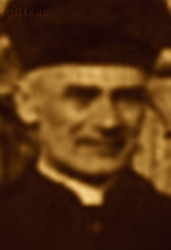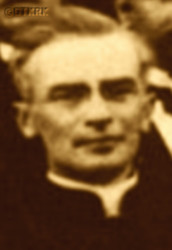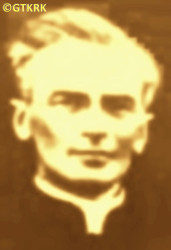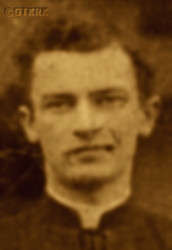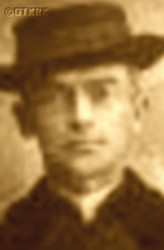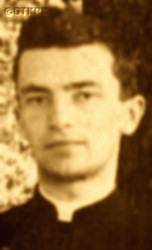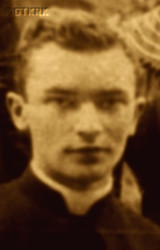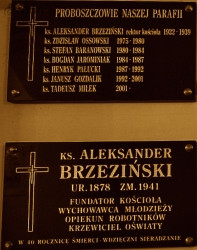Roman Catholic
St Sigismund parish
05-507 Słomczyn
85 Wiślana Str.
Konstancin deanery
Warsaw archdiocese, Poland
full list:
displayClick to display full list

searchClick to search full list by categories
wyświetlKliknij by wyświetlić pełną listę po polsku

szukajKliknij by przeszukać listę wg kategorii po polsku

Martyrology of the clergy — Poland
XX century (1914 – 1989)
personal data
surname
BRZEZIŃSKI
forename(s)
Alexander (pl. Aleksander)
function
diocesan priest
creed
Latin (Roman Catholic) Church RCmore on
en.wikipedia.org
[access: 2014.09.21]
diocese / province
Włocławek diocesemore on
en.wikipedia.org
[access: 2013.05.19]
Włocławek i.e. Kalisz diocesemore on
pl.wikipedia.org
[access: 2019.10.13]
date and place
of death
20.06.1941

Sieradztoday: Sieradz urban gm., Sieradz pov., Łódź voiv., Poland
more on
en.wikipedia.org
[access: 2020.11.05]
details of death
Till 1914, Sieradz, where ministered, was under Russian occupation, in Russian controlled part of partitioned Poland. In 11.1914, after the outbreak of World War I, the German occupation began. Polish military organizations began to emerge, operating illegally and semi‐clandestinely — especially after the so‐called Act of 5thNovember 1916, when the Central Powers, i.e. the German Empire and Austria–Hungary, announced the creation of the Kingdom of Poland, which in 1917 began to materialize in the form of the Germ. Königreich Polen (Eng. Polish Kingdom), governed by the Polish Regency Council, though entirely under the control of the Central Powers. The largest was the Polish Military Organization POW; one of the smaller ones was the Samoobrona Narodowa (Eng. National Self‐Defense), which was formed at the beginning of 11.1918, when it was already becoming obvious that Germany would lose the war. It was founded in the basement of the former Dominican St Stanislav church, of which was rector. Accepted oaths from conspirators and facilitated combat exercises in the temple's basement.
On 11.11.1918, after the abdication on 09.11.1918, of the German Emperor William II Hohenzollern; on the day the armistice and ceasefire between the Allies and Germany was signed in a staff car in Compiègne, at the headquarters of French Marshal Ferdinand Foch — which de facto meant the end of World War I; and also on the day the Regency Council transferred supreme command over the army to Brigadier Joseph Piłsudski and appointed him Supreme Commander of the Polish Army — which de facto meant the rebirth of the Polish state; taken hostage by the Germans to ensure the safe departure of a German unit from Sieradz — according to other accounts in order to prevent spontaneous actions by Polish organizations, such as disarming the Germans in the city, tearing off the wires of their communication systems, and even dismantling the railway tracks. Led the march with rifles aimed at his back. Released next day, on 12.11.1918, on the outskirts of the city. On that day, hand‐to‐hand fighting broke out in Sieradz, during which the 140‐stron German unit killed 5 POW members, and wounded 15.
After German and Russian invasion of Poland in 09.1939 and start of the World War II, after start of German occupation expelled to a neighbouring Chojne parish.
His „Sieradz County” Graphical Institute Germans devastated and robbed.
Avoided mass arrests of Polish priests in Warthegau region — Greater Poland region incorporated into Germany in 1939 — 02‐03.1940 and 26.08.1940.
Next in the spring of 1941 after setting up a German military compounds in Chojne moved to Błota village, c. 30 km from Sieradz.
There for celebration Holy Mass in a small room he stayed in — parish church in Brąszewice was closed by the Germans — for a few local parishioners cruelly beaten up on 17.06.1941 by German Gendarmes.
Unconscious transported to Sieradz hospital where perished three days later.
cause of death
murder
perpetrators
Germans
sites and events
02‐03.1940 arrests (Warthegau)Click to display the description, 26.08.1940 arrests (Warthegau)Click to display the description, Reichsgau WarthelandClick to display the description, Ribbentrop‐MolotovClick to display the description, Pius XI's encyclicalsClick to display the description
date and place
of birth
12.03.1878

Dzierlintoday: Sieradz gm., Sieradz pov., Łódź voiv., Poland
more on
en.wikipedia.org
[access: 2021.12.18]
alt. dates and places
of birth
13.03.1878
presbyter (holy orders)
ordination
29.06.1892

positions held
1922 – 1939
rector — Sieradztoday: Sieradz urban gm., Sieradz pov., Łódź voiv., Poland
more on
en.wikipedia.org
[access: 2020.11.05] ⋄ Blessed Virgin Mary Queen of Poland RC church ⋄ All the Saints RC parish ⋄ Sieradztoday: Sieradz urban gm., Sieradz pov., Łódź voiv., Poland
more on
en.wikipedia.org
[access: 2020.11.05] RC deanery — builder and founder of the church
from 1919
director — „Sieradz County” Graphic Works — founder
director — SieradzBrzeziny district
today: Sieradz urban gm., Sieradz pov., Łódź voiv., Poland
more on
en.wikipedia.org
[access: 2020.11.05] ⋄ Vocational School for Boys — founder
05.01.1919 – 1931
publisher — regional weekly, „Sieradz County” — also: other writings
c. 1909 – c. 1922
curatus/rector/expositus — Sieradztoday: Sieradz urban gm., Sieradz pov., Łódź voiv., Poland
more on
en.wikipedia.org
[access: 2020.11.05] ⋄ St Stanislav the Bishop and Martyr RC church (post‐Dominican) ⋄ All the Saints RC parish ⋄ Sieradztoday: Sieradz urban gm., Sieradz pov., Łódź voiv., Poland
more on
en.wikipedia.org
[access: 2020.11.05] RC deanery — also: prefect at elementary schools, hospital chaplain and prison chaplain
c. 1908 – c. 1909
curatus/rector/expositus — Konintoday: Konin city pov., Greater Poland voiv., Poland
more on
en.wikipedia.org
[access: 2021.12.19] ⋄ St Mary Magdalene RC church (post‐Franciscan) ⋄ St Bartholomew the Apostle RC parish ⋄ Konintoday: Konin city pov., Greater Poland voiv., Poland
more on
en.wikipedia.org
[access: 2021.12.19] RC deanery — also: prefect of a primary school
c. 1907 – c. 1908
resident — Kokanintoday: Żelazków gm., Kalisz pov., Greater Poland voiv., Poland
more on
en.wikipedia.org
[access: 2021.12.18] ⋄ St Mary Magdalene RC parish ⋄ Kalisztoday: Kalisz city pov., Greater Poland voiv., Poland
more on
en.wikipedia.org
[access: 2020.12.16] RC deanery
c. 1907 – c. 1908
vicar — Pyzdrytoday: Pyzdry gm., Września pov., Greater Poland voiv., Poland
more on
en.wikipedia.org
[access: 2020.11.27] ⋄ Nativity of the Blessed Virgin Mary RC parish ⋄ Słupcatoday: Słupca gm., Słupca pov., Greater Poland voiv., Poland
more on
en.wikipedia.org
[access: 2021.12.18] RC deanery — formal posting
c. 1906 – c. 1907
vicar — Rozprzatoday: Rozprza gm., Piotrków Trybunalski pov., Łódź voiv., Poland
more on
en.wikipedia.org
[access: 2020.11.05] ⋄ Visitation of the Blessed Virgin Mary. St Stanislav the Bishop and Martyr and St Bartholmew the Apostle RC parish
c. 1904 – c. 1906
vicar — Tuszyntoday: Tuszyn gm., Łódź‐east pov., Łódź voiv., Poland
more on
en.wikipedia.org
[access: 2021.12.18] ⋄ St Vitalis the Martyr RC parish ⋄ Piotrków Trybunalskitoday: Piotrków Trybunalski city pov., Łódź voiv., Poland
more on
en.wikipedia.org
[access: 2021.07.29] RC deanery
1902 – c. 1904
vicar — Liskówtoday: Lisków gm., Kalisz pov., Greater Poland voiv., Poland
more on
en.wikipedia.org
[access: 2020.11.01] ⋄ All the Saints RC parish ⋄ Turektoday: Turek gm., Turek pov., Greater Poland voiv., Poland
more on
en.wikipedia.org
[access: 2020.12.11] RC deanery
till 1902
student — Włocławektoday: Włocławek city pov., Kuyavia‐Pomerania voiv., Poland
more on
en.wikipedia.org
[access: 2021.12.18] ⋄ philosophy and theology, Theological Seminary
others related
in death
BLIZIŃSKIClick to display biography Vaclav
sites and events
descriptions
02‐03.1940 arrests (Warthegau): First large wave of arrests of Polish Catholic clergy from German occupied Greater Poland region, transformed in to German province Germ. Reichsgau Wartheland (Eng. Greater Poland Reichs District), started in fact in 01.1940 but the largest numbers of priest were captured in 02‐03.1940. In accordance with a plan of „Ohne Gott, ohne Religion, ohne Priesters und Sakramenten” — „without God, without religion, without priest and sacrament” — being implemented by the Germ. Gauleiter (Eng. regional leader) of Germ. Reichsgau Wartheland, Artur Greiser, few hundred of Polish priests were interned in transit camps in Puszczykowo, IL Lubin in Lubiń, IL Bruckau in Bruczków, IL Görchen in Goruszki, IL Chludowo in Chludowo and KL Posen (Fort VII) concentration camp in Poznań, prior to transfer to concentration camps deep within Germany.
26.08.1940 arrests (Warthegau): As part of the Germ. „Ohne Gott, ohne Religion, ohne Priesters und Sakramenten” (Eng. „without God, without religion, without priest and sacrament”) policy, formulated by the Germ. Gauleiter (Eng. district head), Arthur Greiser, in the German province Germ. Reichsgau Wartheland (Eng. Wartheland Reichs District), organized by the Germans in the occupied part of Poland known as Greater Poland, hundreds of Polish priests were arrested on this day. Herded, together with priests arrested previously and held in IL Lond internment camp in Ląd on Warta river camp, among others, in DL Scheglin transit camp in Szczeglin n. Mogilno. Three days later all were transferred to KL Sachsenhausen concentration camp.
Reichsgau Wartheland: After the Polish defeat in the 09.1939 campaign, which was the result of the Ribbentrop‐Molotov Pact and constituted the first stage of World War II, and the beginning of German occupation in part of Poland (in the other, eastern part of Poland, the Russian occupation began), the Germans divided the occupied Polish territory into five main regions (and a few smaller). The largest one was transformed into Germ. Generalgouvernement (Eng. General Governorate), intended exclusively for Poles and Jews and constituting part of the so‐called Germ. Großdeutschland (Eng. Greater Germany). Two were added to existing German provinces. From two other separate new provinces were created. Greater Poland region was one of them, incorporated into Germany on 08.10.1939, by decree of the German leader Adolf Hitler (formally came into force on 26.10.1939), and on 24.01.1940 transformed into the Germ. Reichsgau Wartheland province, in which the law of the German state was to apply. The main axis of the policy of the new province, the territory of which the Germans recognized as the Germ. „Ursprünglich Deutsche” (Eng. „natively German”), despite the fact that 90% of its inhabitants were Poles, was Germ. „Entpolonisierung” (Eng. „Depolonisation”), i.e. forced Germanization. C. 100,000 Poles were murdered as part of the Germ. „Intelligenzaktion”, i.e. extermination of Polish intelligentsia and ruling classes. C. 630,000 were forcibly resettled to the Germ. Generalgouvernement, and their place taken by the Germans brought from other areas occupied by Germany (e.g. the Baltic countries, Bessarabia, Bukovina, etc.). Poles were forced to sign the German nationality list, the Germ. Deutsche Volksliste DVL. As part of the policy of „Ohne Gott, ohne Religion, ohne Priesters und Sakramenten” (Eng. „No God, no religion, no priest or sacrament”) most Catholic priests were arrested and sent to concentration camps. All schools teaching in Polish, Polish libraries, theaters and museums were closed. Polish landed estates confiscated. To further reduce the number of the Polish population, Poles were sent to forced labor deep inside Germany, and the legal age of marriage for Poles was increased (25 for women, 28 for men). The German state office, Germ. Rasse‐ und Siedlungshauptamt (Eng. Main Office of Race and Settlement) RuSHA, under the majesty of German law, abducted several thousand children who met specific racial criteria from Polish families and subjected them to forced Germanization, handing them over to German families. After the end of hostilities of World War II, the overseer of this province, the Germ. Reichsstatthalter (Eng. Reich Governor) and the Germ. Gauleiter (Eng. district head) of the German National Socialist Party, Arthur Karl Greiser, was executed. (more on: en.wikipedia.orgClick to attempt to display webpage
[access: 2024.06.21])
Ribbentrop‐Molotov: Genocidal Russian‐German alliance pact between Russian leader Joseph Stalin and German leader Adolf Hitler signed on 23.08.1939 in Moscow by respective foreign ministers, Mr. Vyacheslav Molotov for Russia and Joachim von Ribbentrop for Germany. The pact sanctioned and was the direct cause of joint Russian and German invasion of Poland and the outbreak of the World War II in 09.1939. In a political sense, the pact was an attempt to restore the status quo ante before 1914, with one exception, namely the „commercial” exchange of the so‐called „Kingdom of Poland”, which in 1914 was part of the Russian Empire, fore Eastern Galicia (today's western Ukraine), in 1914 belonging to the Austro‐Hungarian Empire. Galicia, including Lviv, was to be taken over by the Russians, the „Kingdom of Poland” — under the name of the General Governorate — Germany. The resultant „war was one of the greatest calamities and dramas of humanity in history, for two atheistic and anti‐Christian ideologies — national and international socialism — rejected God and His fifth Decalogue commandment: Thou shall not kill!” (Abp Stanislav Gądecki, 01.09.2019). The decisions taken — backed up by the betrayal of the formal allies of Poland, France and Germany, which on 12.09.1939, at a joint conference in Abbeville, decided not to provide aid to attacked Poland and not to take military action against Germany (a clear breach of treaty obligations with Poland) — were on 28.09.1939 slightly altered and made more precise when a treaty on „German‐Russian boundaries and friendship” was agreed by the same murderous signatories. One of its findings was establishment of spheres of influence in Central and Eastern Europe and in consequence IV partition of Poland. In one of its secret annexes agreed, that: „the Signatories will not tolerate on its respective territories any Polish propaganda that affects the territory of the other Side. On their respective territories they will suppress all such propaganda and inform each other of the measures taken to accomplish it”. The agreements resulted in a series of meeting between two genocidal organization representing both sides — German Gestapo and Russian NKVD when coordination of efforts to exterminate Polish intelligentsia and Polish leading classes (in Germany called «Intelligenzaktion», in Russia took the form of Katyń massacres) where discussed. Resulted in deaths of hundreds of thousands of Polish intelligentsia, including thousands of priests presented here, and tens of millions of ordinary people,. The results of this Russian‐German pact lasted till 1989 and are still in evidence even today. (more on: en.wikipedia.orgClick to attempt to display webpage
[access: 2015.09.30])
Pius XI's encyclicals: Facing the creation of two totalitarian systems in Europe, which seemed to compete with each other, though there were more similarities than contradictions between them, Pope Pius XI issued in 03.1937 (within 5 days) two encyclicals. In the „Mit brennender Sorge” (Eng. „With Burning Concern”) published on 14.03.1938, condemned the national socialism prevailing in Germany. The Pope wrote: „Whoever, following the old Germanic‐pre‐Christian beliefs, puts various impersonal fate in the place of a personal God, denies the wisdom of God and Providence […], whoever exalts earthly values: race or nation, or state, or state system, representatives of state power or other fundamental values of human society, […] and makes them the highest standard of all values, including religious ones, and idolizes them, this one […] is far from true faith in God and from a worldview corresponding to such faith”. On 19.03.1937, published „Divini Redemptoris” (Eng. „Divine Redeemer”), in which criticized Russian communism, dialectical materialism and the class struggle theory. The Pope wrote: „Communism deprives man of freedom, and therefore the spiritual basis of all life norms. It deprives the human person of all his dignity and any moral support with which he could resist the onslaught of blind passions […] This is the new gospel that Bolshevik and godless communism preaches as a message of salvation and redemption of humanity”… Pius XI demanded that the established human law be subjected to the natural law of God , recommended the implementation of the ideal of a Christian state and society, and called on Catholics to resist. Two years later, National Socialist Germany and Communist Russia came together and started World War II. (more on: www.vatican.vaClick to attempt to display webpage
[access: 2023.05.28], www.vatican.vaClick to attempt to display webpage
[access: 2023.05.28])
sources
personal:
sieradz-praga.plClick to attempt to display webpage
[access: 2018.09.02]
original images:
sieradz-praga.plClick to attempt to display webpage
[access: 2018.09.02], sieradz-praga.plClick to attempt to display webpage
[access: 2018.09.02], sieradz-praga.plClick to attempt to display webpage
[access: 2018.09.02], muzeum-sieradz.com.plClick to attempt to display webpage
[access: 2021.12.19], sieradz-praga.plClick to attempt to display webpage
[access: 2018.09.02], sieradz-praga.plClick to attempt to display webpage
[access: 2018.09.02], sieradz-praga.plClick to attempt to display webpage
[access: 2018.09.02], sieradz-praga.plClick to attempt to display webpage
[access: 2018.09.02], sieradz-praga.plClick to attempt to display webpage
[access: 2018.09.02], sieradz-praga.plClick to attempt to display webpage
[access: 2018.09.02]
LETTER to CUSTODIAN/ADMINISTRATOR
If you have an Email client on your communicator/computer — such as Mozilla Thunderbird, Windows Mail or Microsoft Outlook, described at WikipediaPatrz:
en.wikipedia.org, among others — try the link below, please:
LETTER to CUSTODIAN/ADMINISTRATORClick and try to call your own Email client
If however you do not run such a client or the above link is not active please send an email to the Custodian/Administrator using your account — in your customary email/correspondence engine — at the following address:

giving the following as the subject:
MARTYROLOGY: BRZEZIŃSKI Alexander
To return to the biography press below:
 Click to return to biography
Click to return to biography









